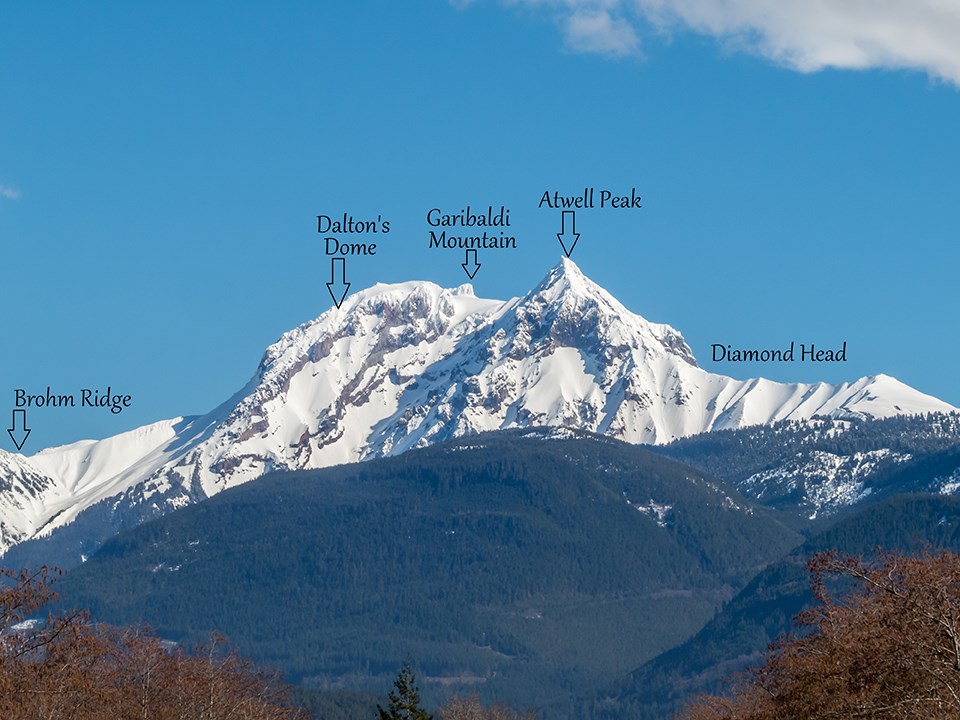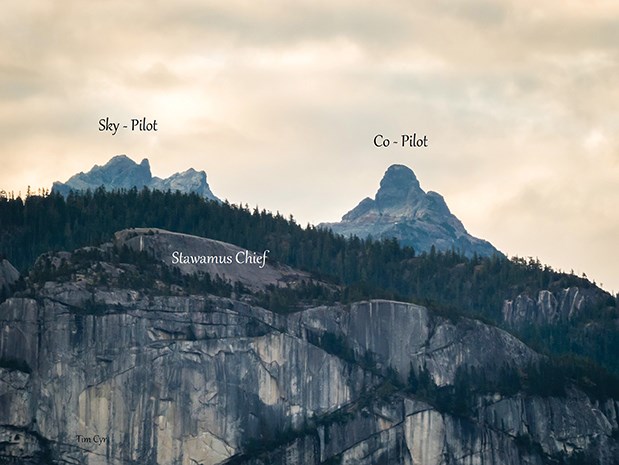Towering over Squamish — magnificently or ominously, depending on the light and one’s disposition — is Mount Garibaldi. A potentially active volcano that last erupted in the Pleistocene age, Garibaldi defines the entire Squamish Valley and Howe Sound, not least because of its prominence but because most of the rocks throughout the region resulted from an almost unprecedented combination of geological events atop this mountain.
“You had a classic battle between fire and ice, between glaciers and the volcano,” says David Crerar, a local mountaineer and author. “You actually had the volcano erupting onto a glacier and immediately freezing. Eventually, the weight of the volcano was such – and the melt of the glacier was such — that there was a collapse and most of the rocks in the Squamish Valley are a result of that massive, massive landslide.”
To the Squamish people, Garibaldi is known as Nch’kay, “grimy one” or “dirty place,” possibly because of the residue left from lava on the melting glacier or, in another interpretation, because of the cloudy water of the Cheekye River, which flows down from one of its peaks.
Why, though, is this prominent landmark named for an Italian general? Like a great number of place names in the area, Captain George Henry Richards, a member of the British Royal Navy who embarked on a mapping expedition around here in 1859 to 1860, named Garibaldi. In addition to being a notable seaman, he was also a keen naval historian and observer of world events. At the time of Richards’ voyage, General Giuseppe Garibaldi was leading the movement to fuse the disparate principalities and duchies of the Italian peninsula into a unified Kingdom of Italy. That may not seem to have a lot of resonance to the West Coast of North America, but it seemed like a good idea to Richards.
“You actually had the volcano erupting onto a glacier and immediately freezing.”
“I don’t know if Richards was a fan of Garibaldi,” says Crear, “but certainly he was in the news as a romantic historic figure in real time and so, I suppose, Richards thought that would be an appropriate name for a glorious mountain.”
Obscure historical references abound in the area, with many place names honouring a 1794 battle off Brittany, called the Glorious First of June, when British Admiral Lord Richard Howe (as in Howe Sound) defeated a French revolutionary fleet attempting to deliver grain to the Americas, according to Crerar’s book.
Richards also named Black Mountain, which is in Cypress Provincial Park, based on its appearance after what must have been a significant forest fire, and many others.
Crerar has spent a great deal of time considering the names of local landmarks. In addition to being a lawyer, mountain-climber and trail-runner, Crerar co-authored a book on mountains of the North Shore, along with his son Harry Crerar and avocational cartographer Bill Maurer. The Glorious Mountains of Vancouver’s North Shore: A Peakbagger’s Guide was published last year and, while technically it covers only as far north as Capilano Mountain, which is south of Squamish, Crerar’s knowledge extends further. How mountains and peaks got their names opens a Pandora’s box of historical anecdotes.
While Richards is not a household name in these parts, a more familiar figure from a century earlier is responsible for some of the most prominent place names in Howe Sound. In the last decade of the 18th century, which also turned out to be the last decade of his life, Captain George Vancouver made two expeditions to what is now British Columbia.
“At the mouth of the Fraser River, there are thick, dangerous mud flats that are tricky to navigate through.”

“When you’re driving up to Squamish from Vancouver, the most dramatic mountain in Howe Sound, on Anvil Island, is called Leading Peak,” says Crerar. Vancouver named both the island (because, with a little imagination, it can resemble a dropped anvil) and the peak, which served as a beacon of sorts.
“At the mouth of the Fraser River, there are thick, dangerous mud flats that are tricky to navigate through,” says Crerar. Vancouver figured out that if one drew a straight line from the mouth of the Fraser to this very prominent “leading peak,” it would provide safe passage through the mud flats.
More recently, members of the B.C. Mountaineering Club and the University of B.C.’s Varsity Outdoor Club named many area landmarks in the late-19th and early-20th centuries. These clubs set out to climb (or, in the terminology of the sport, “bag”) most of the peaks in the region.
Some of the monikers given to peaks by these groups are self-referential or in-jokes. Bookworm Peak was one of the UBC club’s inventions.
Among the highest peaks on Garibaldi are Dalton Dome and Atwell Peak, named after two of the first ascenders of Garibaldi, in August 1907.
“Their names are Atwell King and Arthur Dalton,” says Crerar, noting that one used their surname and the other their given name. These two were also among the first climbers to ascend the Lions, in 1903, and went on to help found the B.C. Mountaineering Club four years later.
“There are a lot of place names called the Chief.”
The local sightseeing and charter company Sea To Sky Air has assembled a list of some of their favourite local place names, including the ominously titled Famine Peak and the theological-sounding Devil Peak and Brimstone Mountain. Similarly fraught names include Devastator Peak and Phantom Mountain, as well as Abandoned Peak, The Witness, Snowblood Mountain and The Frost Fiend. Those with an itch for climbing could consider Ice Flea Peak while arachnophilic outdoors folk might head for Snowspider Mountain.
Many of these places, of course, had names long before English-speakers tagged them. In advance of the 2010 Olympics, many Indigenous place names in the Sea to Sky region were restored and the local First Nations are in various stages of documenting the earlier place names.
Interestingly, the name of the geological structure most closely associated with Squamish, the Stawamus Chief, has a slightly uncertain origin. By some accounts, the granite monolith has had a spiritual significance to the Indigenous people for ages. Stawamus was the name of the village at the foot of the mountain and “chief” is a rough translation of Siám’, though the term apparently reflects a social ranking of which chief is a fairly unsophisticated substitute. The reason it was given that name at all seems to be lost to history.
“There are a lot of place names called the Chief,” Crerar says. “I’m not sure if it commemorates a specific Squamish chief or if that was simply a suitable name for such a prominent and beautiful monolith.”



